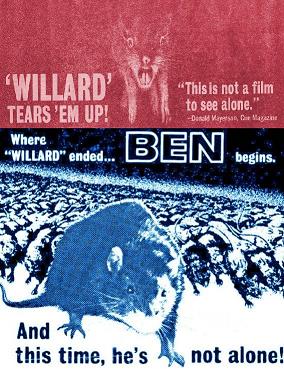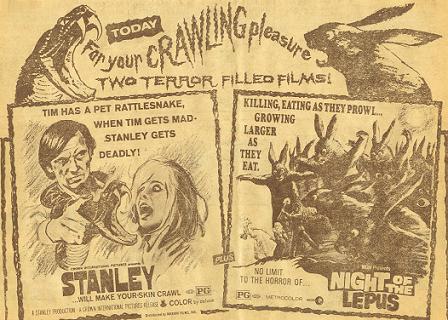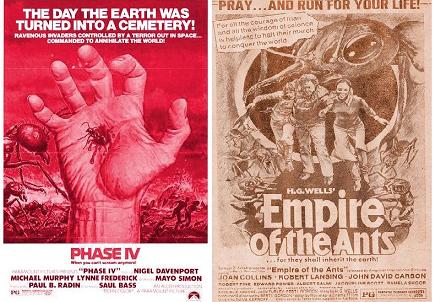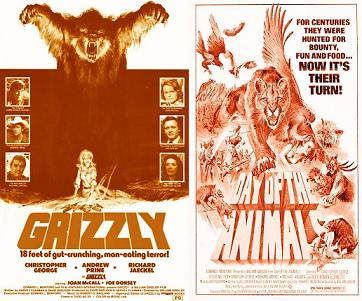The Lost Drive-In: Nature Runs Amuck!
 The 1970’s was a great decade for fans of exploitation cinema. What was once considered a second tier genre was now being embraced by major distributors and becoming available to every area of the country. One of the more entertaining sub-categories of this was the “nature runs amuck” films that became very popular. Perhaps it was the country becoming more ecologically conscious or the hippie movement needing a new target now that the Vietnam War had fallen out of style or evening the rising oil shortages, but the environment was a hot topic. At the movies, this concern translated itself into nature striking back against mankind for pollution, overpopulation, and insensitivity. It seemed like just about everything that could hop, crawl, or slither was out to get us!
The 1970’s was a great decade for fans of exploitation cinema. What was once considered a second tier genre was now being embraced by major distributors and becoming available to every area of the country. One of the more entertaining sub-categories of this was the “nature runs amuck” films that became very popular. Perhaps it was the country becoming more ecologically conscious or the hippie movement needing a new target now that the Vietnam War had fallen out of style or evening the rising oil shortages, but the environment was a hot topic. At the movies, this concern translated itself into nature striking back against mankind for pollution, overpopulation, and insensitivity. It seemed like just about everything that could hop, crawl, or slither was out to get us!
The granddaddy of this entire film cycle was 1971’s Willard starring Bruce Davison. This story of an ineffectual loser who is taken advantage of at every turn takes the fast train to creepy town when he learns he has a knack for training rats. In no time, Willard has the hairy little plague spreaders doing his bidding and exacting a little payback on his enemies. Sadly, like most anti-heroes, Willard doesn’t know when to quit while he’s ahead and he eventually ends up Purina Rat Chow!
After Willard proved to be a big hit at the box office and caused the extermination business to boom, the film’s producers scampered, I mean rushed, to get a sequel into the theaters the following year. Ben continues the tale (or is it tail?) of one of Willard’s rats who escapes into the Los Angeles’ sewers and starts to build an army of his own. To try to add a little compassion to the story, Ben also befriends a sickly young boy who puts on puppet shows and sings to the disease ridden rodent. Ben was no Willard and plays more like a made for television movie with very little bite. Even if it was an inferior sequel, Ben will always be remembered for the title song sung by no less than Michael Jackson! I’m not sure if Willard and Ben were ever re-released as a double feature but they would have made a good one.
 Speaking of double features, our next two films did play together although they weren’t as well matched. William Grefe’s Florida snake fest Stanley (1972) stars Chris Robinson as a very Willard like character. In this case he is a Seminole Indian who returns to his Florida home after serving in Vietnam only to find prejudice and corruption. Turning to his rattlesnake brothers for help, Chris starts dispatching his tormentors in venomous fashion. The similarities between Willard and Stanley don’t end there either, Chris gets corrupted by his own power and Stanley ends up having to bite the hand that feeds him!
Speaking of double features, our next two films did play together although they weren’t as well matched. William Grefe’s Florida snake fest Stanley (1972) stars Chris Robinson as a very Willard like character. In this case he is a Seminole Indian who returns to his Florida home after serving in Vietnam only to find prejudice and corruption. Turning to his rattlesnake brothers for help, Chris starts dispatching his tormentors in venomous fashion. The similarities between Willard and Stanley don’t end there either, Chris gets corrupted by his own power and Stanley ends up having to bite the hand that feeds him!
Sharing the other half of the bill with Stanley is Night of the Lepus, a throwback to science fiction movies of the 50’s. Rabbits (also the film’s original title) infected with experimental hormones to stunt their reproduction, grow to gigantic proportions and overrun a remote western town. The herd of horrible hares begins to march (or at least hop) on a larger city until the National Guard gets involved and turns them into bunny burgers. MGM wisely retitled the film Night of the Lepus prior to release and removed all traces of anything remotely rabbit-like from the advertising campaign. I love the artwork used for this re-release double feature that realized most people already knew the film was about killer bunnies and tries to make them look as ferocious as possible.
 Ants haven’t been as popular in horror films as other creepy creatures like spiders and snakes although they did star one of the best of the 50’s films, Them. In the 1970’s, we got not one but two ant flicks and aside from the insect stars, the films couldn’t have been more different.
Ants haven’t been as popular in horror films as other creepy creatures like spiders and snakes although they did star one of the best of the 50’s films, Them. In the 1970’s, we got not one but two ant flicks and aside from the insect stars, the films couldn’t have been more different.
Phase IV (1974) took the highbrow approach to cheesy science fiction and tried to handle its story of ants inexplicably evolving at an accelerated rate entirely seriously. A two man research team at a desert facility studies the ants and gradually enters into a war with them that ants are destined to win. While many of the individual scenes are interesting, the tone is as dry as the desert surroundings and things get boring fast. The ending is also convoluted and left open to interpretation so Phase IV got phased out without ever finding an appreciative audience.
Three years later in 1977, another ant film popped up that tried to be highbrow in name only. Copping the title but nothing else from a short story by H. G. Wells, Empire of the Ants went the route of Them and gave audiences giant ants mutated by radioactive waste. Producer / Director Bert I. Gordon was already a legend in the giant monster business, thanks to films like The Amazing Colossal Man and Earth vs. The Spider, by the time Empire came along. Unfortunately, his special effects had not progressed very far since the fifties so we get a lot of footage of real ants crawling across photographs superimposed over people pointing and screaming. While Empire completely abandons its source material, the resulting story of giant ants taking over a small town and its sugar refinery is actually pretty interesting but the lame special effects kept it from rising to anything more than a B movie.
 Our final two films this week come from an unsung hero of exploitation films, William Girdler. He had already made films like Three on a Meat Hook and Asylum of Satan by 1976 when he directed the unapologetic Jaws knock-off Grizzly. While viewing this film, you can almost imagine someone sitting down with the script from Jaws and substituting the word bear for shark every time it pops up. The film stars Christopher George, a solid actor who deserved better roles that he ultimately got, as the park ranger equivalent of Martin Brody, Andrew Prine as a burned out Vietnam vet helicopter pilot, and Richard Jaeckel as a bear expert! After lots of POV bear kills in the woods, and a rousing soliloquy by Prine about how he was forced to burn entire villages in ‘Nam, Chris squares off against the mammoth mammal with a rocket launcher and we get a Jaws-style ending as well! When the film was sold to television a few years later, it was retitled Killer Grizzly presumably to distance itself from those fun loving bears that were content stealing picnic baskets and wished no harm on humanity.
Our final two films this week come from an unsung hero of exploitation films, William Girdler. He had already made films like Three on a Meat Hook and Asylum of Satan by 1976 when he directed the unapologetic Jaws knock-off Grizzly. While viewing this film, you can almost imagine someone sitting down with the script from Jaws and substituting the word bear for shark every time it pops up. The film stars Christopher George, a solid actor who deserved better roles that he ultimately got, as the park ranger equivalent of Martin Brody, Andrew Prine as a burned out Vietnam vet helicopter pilot, and Richard Jaeckel as a bear expert! After lots of POV bear kills in the woods, and a rousing soliloquy by Prine about how he was forced to burn entire villages in ‘Nam, Chris squares off against the mammoth mammal with a rocket launcher and we get a Jaws-style ending as well! When the film was sold to television a few years later, it was retitled Killer Grizzly presumably to distance itself from those fun loving bears that were content stealing picnic baskets and wished no harm on humanity.
While not as successful as Grizzly, Girdler’s follow up film, Day of the Animals (1977), was at least a little more original. George and Jaeckel return along with a whole horde of second-tier actors including Leslie Nielsen, Ruth Roman, and Chris’s wife Lynda Day George. The fairly believable premise has a pollution produced hole in the ozone layer allowing cosmic radiation to leak down on a high altitude town. This radiation causes animals and unstable humans to go crazy and attack anything that crosses their path. A group of tenderfoot hikers lead by George get trapped in the mountains and assaulted by birds, wolves, mountain lions and other crazy critters as they try to escape back to civilization. A stand out scene features a cameo by the bear from Grizzly going one on one with a delightfully demented Neilson in a very mismatched fist fight.
After a less than spectacular run in theaters, Day was later re-released under the title Something is Out There with an ambiguous ad campaign that did not show any animals. Girdler abandoned animal films after this and tried to rip off The Exorcist next with a film called The Manitou. Unfortunately, the scariest thing in that film was Tony Curtis and Girdler was tragically killed in a helicopter accident a short time later, ending his brief exploitation career at the age of only 30.
This concludes our feature presentation sampling nature run amuck films from the 1970’s. Thank you for visiting the Lost Drive-In. Please remember to remove the speakers from your car windows before exiting the lot. The management wishes you a safe drive home and a good night.
